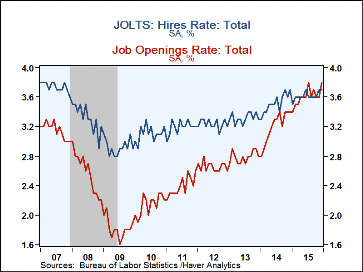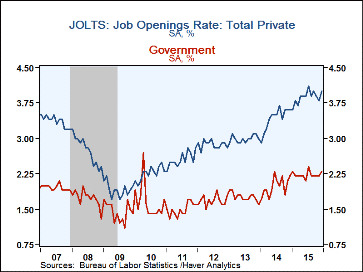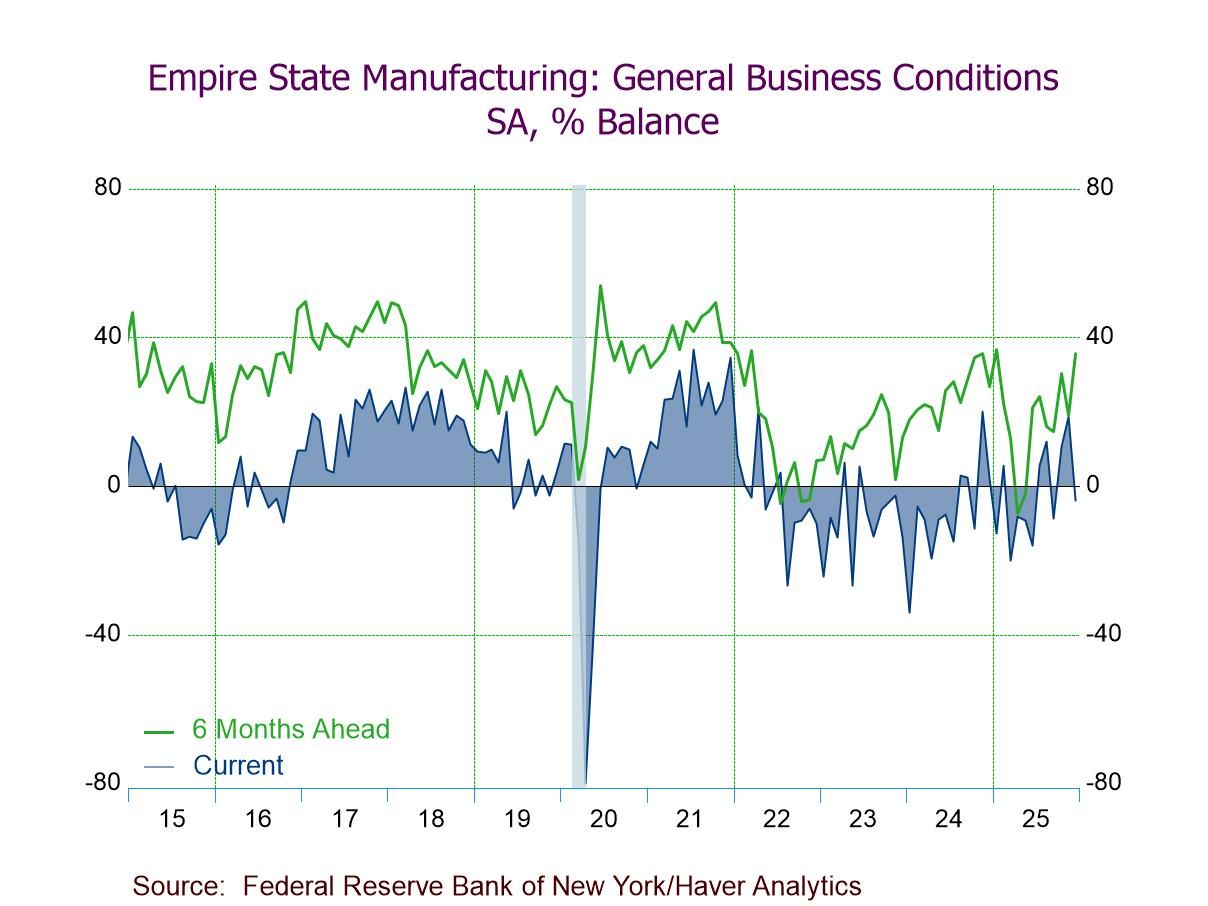 Global| Feb 09 2016
Global| Feb 09 2016U.S. JOLTS: Job Openings Rate Increases to Record High
by:Tom Moeller
|in:Economy in Brief
Summary
The job market improved greatly last year. The job openings rate increased to 3.8% for the full-year, a record high for the series which dates back to 2000. It improved to 3.8% during December, also a record high, up from 3.4% in [...]
The job market improved greatly last year. The job openings rate increased to 3.8% for the full-year, a record high for the series which dates back to 2000. It improved to 3.8% during December, also a record high, up from 3.4% in December 2014. The private sector job openings rate of 4.0% compared to 2.3% in the public sector. The job openings rate is the number of job openings on the last business day of the month as a percent of total employment plus job openings. Hiring was less ebullient. The hires rate of 43.4% for the full-year was well below the 47.2% high in 2001. The December reading held at 3.7% for the second month. The private sector rate of 4.1% compared to 1.7% in the public sector. The hires rate is the number of hires during the month divided by employment. The Bureau of Labor Statistics reports these figures in its Job Openings & Labor Turnover Survey (JOLTS).
The actual number of job openings increased 15.0% for the full-year, less than the 2014 gain of 22.6%. Openings rose 4.9% in December to 5.607 million and were 15.0% higher versus 2014. An 15.7% y/y rise in private sector openings was led by a 47.9 surge in construction. That was followed by a 21.4% y/y increase in health care & social assistance. Factory sector openings improved 17.7% y/y. That was followed by 9.3% y/y growth in retail, 9.2% y/y growth in leisure & hospitality and a 7.4% y/y improvement in professional & business services. In the government sector, job openings increased 8.1% y/y.
The number of hires increased 4.6% during all of 2015, less than the 8.4% 2014 rise. In December, they rose 2.3% y/y to 5.361 million. Private sector hiring grew 1.5% y/y, reflecting a 13.2% increase in leisure & hospitality hiring, but a 28.3% y/y decline in the number of construction sector jobs. Professional & business services employment grew 7.1% y/y while health care & social assistance jobs improved 3.2%. The factory sector shed 1.4% of its workers while retail trade jobs declined 2.2% y/y. Government sector hiring advanced 15.0% y/y.
The total job separations rate remained at 3.5%. That was down from a 3.6% March high. The actual number of separations increased 3.5% y/y. Factory sector separations increased 6.7% y/y while education & health care separations gained 3.7% y/y. Professional & business services separations increased 8.8% y/y and leisure & hospitality separations rose 12.7% y/y. Retail trade separations declined 1.7% y/y. Separations include quits, layoffs, discharges, and other separations as well as retirements.
The layoff & discharge rate returned to a record low 1.1%. The private sector rate of 1.2% was an all-time low and that compared to 0.5% in the public sector. Layoffs overall declined 8.4% y/y in the private sector but jumped 18.6% y/y in the public sector.
The JOLTS survey dates to December 2000 and the figures are available in Haver's USECON database.
| JOLTS (Job Openings & Labor Turnover Survey, SA) | Dec | Nov | Oct | Dec '14 | 2015 | 2014 | 2013 |
|---|---|---|---|---|---|---|---|
| Job Openings, Total | |||||||
| Rate (%) | 3.8 | 3.6 | 3.6 | 3.4 | 3.8 | 3.4 | 2.8 |
| Total (000s) | 5,607 | 5,346 | 5,349 | 15.0% | 15.0 | 22.6% | 9.3% |
| Hires, Total | |||||||
| Rate (%) | 3.7 | 3.7 | 3.6 | 3.7 | 43.4 | 42.2 | 39.8 |
| Total (000s) | 5,361 | 5,256 | 5,168 | 2.3% | 4.6% | 8.4% | 3.4% |
| Layoffs & Discharges, Total | |||||||
| Rate (%) | 1.1 | 1.2 | 1.2 | 1.2 | 14.7 | 14.5 | 14.6 |
| Total (000s) | 1,607 | 1,686 | 1,703 | -6.8% | 1.3% | 2.4% | -4.9% |
Tom Moeller
AuthorMore in Author Profile »Prior to joining Haver Analytics in 2000, Mr. Moeller worked as the Economist at Chancellor Capital Management from 1985 to 1999. There, he developed comprehensive economic forecasts and interpreted economic data for equity and fixed income portfolio managers. Also at Chancellor, Mr. Moeller worked as an equity analyst and was responsible for researching and rating companies in the economically sensitive automobile and housing industries for investment in Chancellor’s equity portfolio. Prior to joining Chancellor, Mr. Moeller was an Economist at Citibank from 1979 to 1984. He also analyzed pricing behavior in the metals industry for the Council on Wage and Price Stability in Washington, D.C. In 1999, Mr. Moeller received the award for most accurate forecast from the Forecasters' Club of New York. From 1990 to 1992 he was President of the New York Association for Business Economists. Mr. Moeller earned an M.B.A. in Finance from Fordham University, where he graduated in 1987. He holds a Bachelor of Arts in Economics from George Washington University.










